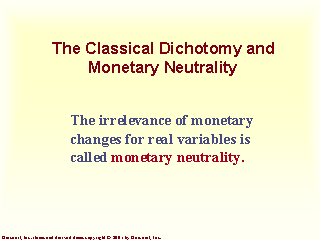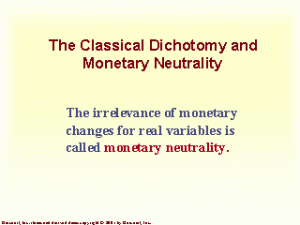David Hume and his contemporaries suggested that economic variables should be divided into two groups.
The first group consists of nominal variables – variables measured in monetary units. The second group consists of real variables – variables measured in physical units.
For example, the income of corn farmers is a nominal variable because it is measured in rupees, whereas the quantity of corn the produce is a real variable because it is measured in bushels. Nominal GDP is nominal variable because it measures the rupee value of economy’s output of goods and services; real GDP is a real variable because it measures the total quantity of goods and services produced and is not influenced by current prices of those goods and services. The separation of real and nominal variables is called the classical dichotomy.
Most prices are quoted in units of money and, therefore, are nominal variables. When we say that the price of corn is Rs. 2 a bushel or that price of wheat is Re. 1 a bushel, both prices are nominal variables. But we can also say that the price of a bushel of corn is 2 bushels of wheat. This is relative price, it is not measured in terms of money. Hence, relative prices are real variables.
The classical dichotomy is useful because different forces influence real and nominal variables. According to classical analysis, nominal variables are influenced by developments in economy’s monetary system, whereas money is largely irrelevant for explaining real variables.
Changes in the supply of money, according to classical analysis, affect nominal variables but not real ones. When the central bank doubles the money supply, the price level doubles, the rupee wage doubles, and all other rupee values double. Real variables, such as production, employment, real wages, and real interest rates, are unchanged.
The irrelevance of monetary changes for real variables is called monetary neutrality.
Click here for government certifications





4 Comments. Leave new
Good effort!
Nice work!!
NO idea about this topic 😀
But tried to get what you tried to express by reading ti :F
Very well articulated 😀
well explained.